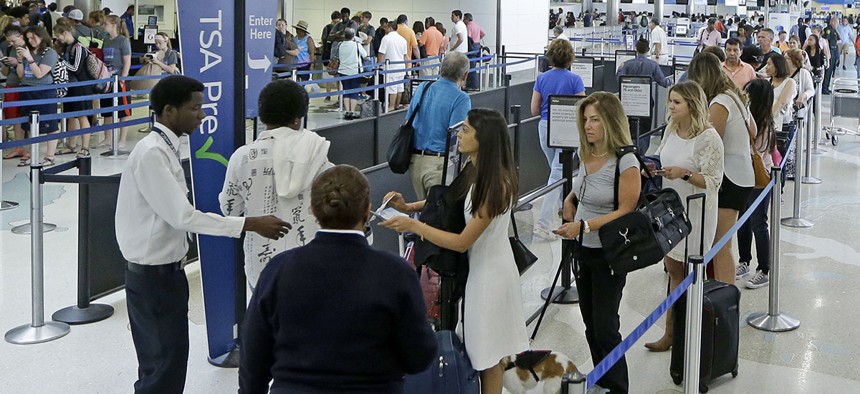TSA Curb-to-Gate Security Monitoring Is Coming, Agency Administrator Says

Travelers stand in line as they prepare go to through a Transportation Security Administration checkpoint at Fort Lauderdale-Hollywood International Airport, Friday, May 27, 2016 Alan Diaz/AP
One proposal: RFID-tagged bins for carry-on luggage that roll down automatic conveyor belts for X-ray inspection.
U.S. airports today offer free-standing charging stations, motorized toilet seat covers, food delivery via iPad and other high-tech conveniences. But the Transportation Security Administration is still stuck figuring out how to queue bags and people.
TSA Administrator Peter V. Neffenger told lawmakers on Tuesday he has a plan to streamline lines from curb-to-gate, all while keeping security in check.
One example: RFID-tagged bins for carry-on luggage that roll down automatic conveyor belts for X-ray inspection.
Instead of passengers pushing and pulling bins in a single-file line, fliers would simply drop their belongings at one of five stations and the bin moves through on its own. Fliers with a lot of stuff would not hold up those behind them in line.
Delta and Atlanta's Hartsfield-Jackson International Airport saw a 30 percent increase in throughput during a two-lane trial, Neffenger said.
The frustrating part is self-propelled bins aren't even a new technology. London's Heathrow Airport has been using automatic conveyor belts for carry-on baggage for years.
Delta reportedly spent $1 million on researching and purchasing automated rollers, after Neffenger rallied airlines and airports to reboot the air travel experience upon taking office in June 2015, he said.
The RFID chips on the bins "are tracked to the individual,” helping to profile both the passenger and the passenger’s cargo, Neffenger said.
“It makes it much easier to divert a bag if there is an image of concern -- and it pulls the person whose bag has been diverted off the line," he said.
"This is where I see the greatest promise going forward," Neffenger said of efforts to automate the screening process.
Buy-in from other air travel organizations could lead to electronic gates that let you into a checkpoint and ID checks out in the kiosk area to “keep the person sterile as they come through, really building that true curb-to-gate security environment, as opposed to just focusing it all around the checkpoint,” he said.
About a dozen airports are in talks with TSA about participating in some of this transformation over the next six months, Neffenger said.
Airport security is taking heat this summer from passengers and internal auditors over hours-long waits for screening at airports nationwide and concerns about flight safety after the mysterious disappearance of EgyptAir Flight 804 last month.
The automatic rollers for carry-on luggage are "an example of the way in which we need to modernize and bring TSA in to [the] 21st century," Neffenger told senators at a Homeland Security and Governmental Affairs Committee hearing.
Right now, TSA lacks visibility into the ease and speed with which people and baggage are moving, partly out of network security concerns.
"I can’t currently see the health of the system because I have independently operating entities out there that can’t be networked together because of cybersecurity reasons," Neffenger said. "I need to do a better job of getting real-time performance data ... It’s a very manual system right now."



